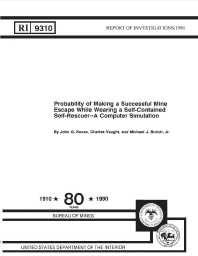Mining Publication: Probability of Making a Successful Mine Escape While Wearing a Self-Contained Self-Rescuer - A Computer Simulation
Original creation date: January 1990
In an effort to estimate the chances of a miner making a successful escape while wearing a self contained self rescuer (SCSR), a computer simulation was developed which takes into account training in the use of SCSRs, integrity of the apparatus, and oxygen cost of a mine escape. Survival odds for a prototypical escape, and how these odds change when SCSR training is improved were examined. The simulation was applied to four mines that were part of an SCSR donning proficiency field study. The results show that relative survival odds for different mines can vary by as much as 30% and that this difference is due to SCSR donning proficiency. The results also confirm the common sense view that using an SCSR is the best survival strategy and the only one that is tenable over long distances. The real limitation on escape distance was that SCSRs make available only a finite quantity of usable oxygen. This must be taken into account in planning for mine emergencies. The authors suggest that computer simulation may be useful in helping determine where to store SCSR caches along escape routes, in decision making under uncertainty with regard to the choice of which escape route to use, and in group dynamics in mine emergencies.
Authors: JG Kovac, C Vaught, MJ Brnich
Report of Investigations - January 1990
NIOSHTIC2 Number: 00202849
U.S. Department of the Interior, Bureau of Mines. Report of Investigations 9310, 1990 Jan; :1-11
See Also
- The Critical Ventilation Velocity in Tunnel Fires - A Computer Simulation
- Cryogenic Life Support Technology Development Project
- Development of both a Dockable and Hybrid Person-Wearable Self-Contained Self-Rescuer
- Development of Components for Breathing Escape Apparatus (DSOV)
- Development of Components for Breathing Escape Apparatus (DSOV/HMC)
- Expectations Training for Miners using Self-Contained Self-Rescuers in Escape from Underground Coal Mines
- Probability of Making a Successful Mine Escape While Wearing a Self-Contained Self-Rescuer
- Safety Aspects of Mine Ventilation Through Technical Development and Training
- Safety, Health, and Ventilation Cost Benefit Optimization with Simulation and Control
- Smart Escape SCBA
- Content source: National Institute for Occupational Safety and Health, Mining Program


 ShareCompartir
ShareCompartir
